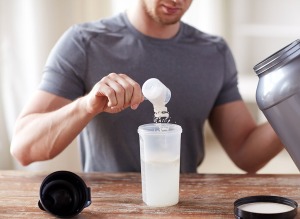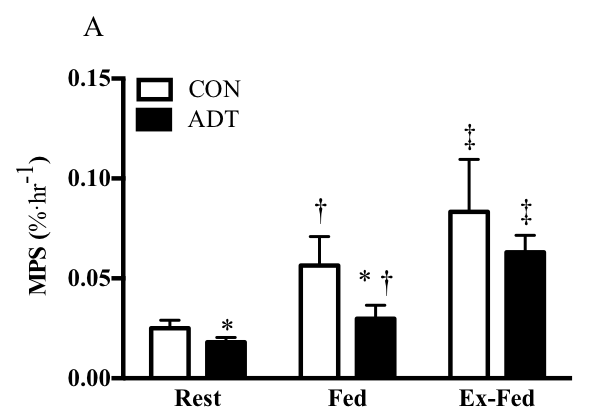Research Team Members: Erik Hanson, Andre Nelson, Daniel West, John Violet, Lannie O’Keefe, Stuart Phillips, Alan Hayes
These findings were recently published in Journal of Clinical Endocrinology and Metabolism, March 2017, 102(3): 1076-1083
Why did you do this study?
Prostate cancer is the most common non-dermatological form of cancer in US men (diagnosed in 1 in 7 men) and is the second leading cause of cancer-related death. In 2017 alone, it is estimated that 161,360 new cases of prostate cancer will be diagnosed with 26,730 deaths.
Androgen deprivation therapy (ADT) is a type of prostate cancer treatment that slows tumor growth but has several side effects, including the loss of muscle mass, strength, and physical function. All of these changes have a negative impact upon health-related quality of life. Exercise interventions have become more common to help reduce treatment-related side effects. Specifically, resistance training during ADT improves muscle strength, reduces fatigue, and enhances physical function. However, it is unclear as to whether or not significant gains in muscle mass are possible during ADT.
Looking at the recent literature, some studies have reported that no muscle hypertrophy occurs with resistance training during ADT. Others have shown that muscle gains are possible but the response is attenuated. Recently, our lab has demonstrated that high intensity resistance training induces gains in lean mass that are comparable to healthy, age-matched controls.
 Protein supplementation is often used with resistance training to enhance the response. However, very few studies have combined these two muscle building strategies and used them during ADT as a means of preserving lean muscle mass and function and no studies have looked at the muscle protein synthesis response. Determining the acute response initially will provide important information for desiging future resistance exercise and dietary interventions, as it is repeated transient increases in muscle protein synthesis that may lead to increases in lean tissue over time.
Protein supplementation is often used with resistance training to enhance the response. However, very few studies have combined these two muscle building strategies and used them during ADT as a means of preserving lean muscle mass and function and no studies have looked at the muscle protein synthesis response. Determining the acute response initially will provide important information for desiging future resistance exercise and dietary interventions, as it is repeated transient increases in muscle protein synthesis that may lead to increases in lean tissue over time.
Therefore, the purpose of this study was to determine the acute muscle protein response to whey protein supplementation with and without resistance exercise in men being treated for prostate cancer with ADT and healthy controls. We hypothesized that baseline protein synthesis would be suppressed with ADT but that diet- and exercise-induced increased in protein synthesis would be normal.
What did you do and what did you find in this study?
We measured muscle protein synthesis (MPS) from biopsy samples obtained from the thigh muscles at rest and 4h after participants consumed 40g of whey protein (Fed) and 40g of whey protein plus 3 sets of knee extension resistance exercise (Ex-Fed).
Muscle protein synthesis was lower during ADT at rest and while feeding (Fed) increased the rate of synthesis, the response was attenuated. However, the change in muscle protein synthesis from rest to Ex-Fed was similar to healthy controls.

* Significantly different from CON at the specific time point, P<0.01
† Significantly different from baseline value, P<0.001
‡ Significantly different from baseline and FED condition, P<0.001
How do these findings impact the public?
Muscle protein synthesis at rest is lower with ADT, which is likely why there is the loss of muscle mass in these patients. However, muscle protein synthesis increases following large doses of whey protein, although it is not as effective during ADT. But the combination of whey protein and vigorous resistance exercise may be an effective means to offset the side effects of prostate cancer treatment.
Future studies are needed to explore why protein synthesis is activated less with feedling alone, as this ‘anabolic resistance’ may have significant consequences for men on ADT. We are currently developing projects that will help to clarify these findings in the future.
